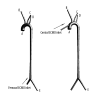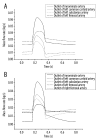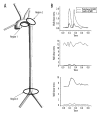Hemodynamic Differences Between Central ECMO and Peripheral ECMO: A Primary CFD Study
- PMID: 26938949
- PMCID: PMC4780269
- DOI: 10.12659/msm.895831
Hemodynamic Differences Between Central ECMO and Peripheral ECMO: A Primary CFD Study
Abstract
BACKGROUND Veno-arterial extracorporeal membrane oxygenation (VAECMO), including central ECMO (cECMO) and peripheral ECMO (pECMO), is widely used in cardiopulmonary surgery. The outcomes and complications of both types of ECMO are quite different from each other. The hemodynamic differences among them are hypothesized as a key factor. Hence, a numerical study was conducted to test this hypothesis. MATERIAL AND METHODS Ideal cardiovascular models with pECMO and cECMO were established. The aortic pressure and flow rate were chosen as boundary conditions. The flow pattern, blood flow distributions, flow junction, harmonic index (HI) of blood flow, wall shear stress (WSS), and the oscillatory shear index (OSI) were calculated to evaluate the hemodynamic states. RESULTS pECMO could achieve better upper limb and brain perfusion (0.05458 vs. 0.05062 kg/s), and worse lower limb perfusion (0.03067 vs. 0.03401 kg/s). There exist low WSS (<0.4 pa) regions at the inner and posterior wall of the aorta, and high WSS (>2 pa) region at the access of the femoral artery. These regions also have relatively high OSI value (reaching 0.45). In contrast, for cECMO, there exist high WSS at the posterior wall of the aortic arch. CONCLUSIONS The hemodynamic performances of various types of ECMO are different from each other, which maybe the key reasons for the differences in the outcomes and complications. Therefore, for pEMCO, the lower-extremity ischemia is a complication that must be considered. The type, support level, and duration of ECMO should also be carefully regulated according to the patients' condition, as they are the important factors related to vascular complications.
Figures








References
-
- Marasco SF, Esmore DS, Negri J, et al. Early institution of mechanical support improves outcomes in primary cardiac allograft failure. J Heart Lung Transplant. 2005;24(12):2037–42. - PubMed
-
- Fiser S, Tribble CG, Kaza AK, et al. When to discontinue extracorporeal membraneoxygenation for postcardiotomy support. Ann Thorac Surg. 2001;71:210–14. - PubMed
-
- Hill JD, O’Brien TG, Murray JJ, et al. Prolonged extracorporal oxygenation of acute posttraumatic respiratory failure(shock-lung syndrome) N Engl J Med. 1972;286:629–34. - PubMed
-
- Bartlett RH, Roloff DW, Custer JR, et al. Extracorporeal life support: the University of Michigan experience. JAMA. 2000;283:904–8. - PubMed
-
- Marasco SF, Lukas G, McDonald M, et al. Review of ECMO (extra corporeal membrane oxygenation) support in critically ill adult patients. Heart Lung Circ. 2008;17:S41–47. - PubMed
Publication types
MeSH terms
LinkOut - more resources
Full Text Sources
Research Materials
Miscellaneous

